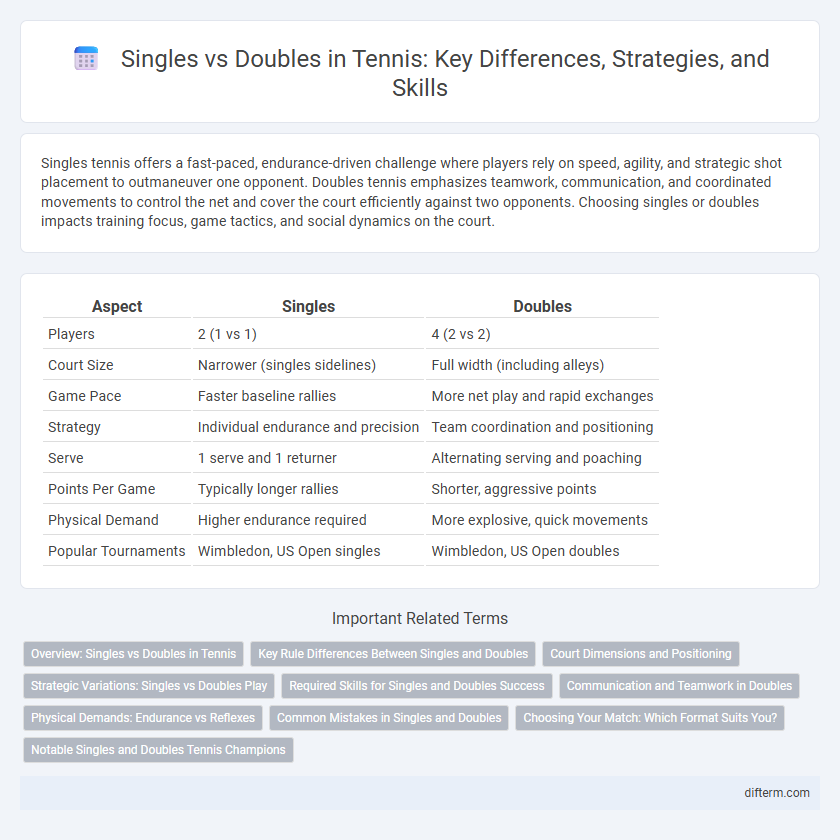Singles tennis offers a fast-paced, endurance-driven challenge where players rely on speed, agility, and strategic shot placement to outmaneuver one opponent. Doubles tennis emphasizes teamwork, communication, and coordinated movements to control the net and cover the court efficiently against two opponents. Choosing singles or doubles impacts training focus, game tactics, and social dynamics on the court.
Table of Comparison
| Aspect | Singles | Doubles |
|---|---|---|
| Players | 2 (1 vs 1) | 4 (2 vs 2) |
| Court Size | Narrower (singles sidelines) | Full width (including alleys) |
| Game Pace | Faster baseline rallies | More net play and rapid exchanges |
| Strategy | Individual endurance and precision | Team coordination and positioning |
| Serve | 1 serve and 1 returner | Alternating serving and poaching |
| Points Per Game | Typically longer rallies | Shorter, aggressive points |
| Physical Demand | Higher endurance required | More explosive, quick movements |
| Popular Tournaments | Wimbledon, US Open singles | Wimbledon, US Open doubles |
Overview: Singles vs Doubles in Tennis
Singles tennis features two players competing head-to-head, emphasizing stamina, speed, and baseline rallies. Doubles tennis involves teams of two, highlighting coordination, communication, and net play strategies. The court dimensions differ, with doubles utilizing the full width and singles using a narrower court.
Key Rule Differences Between Singles and Doubles
Singles tennis involves two players competing one-on-one, where the court's narrower sidelines define the in-bounds area. Doubles tennis features four players, with wider alleys included within the court boundaries to accommodate team play. Serving rotation also differs, as doubles require each player on a team to serve in turn every four points, while singles players serve continuously until the service game changes.
Court Dimensions and Positioning
Singles tennis courts measure 27 feet wide and 78 feet long, while doubles courts extend to 36 feet wide, utilizing the alleys on each side for broader play. Positioning in singles centers on controlling the baseline and exploiting the narrower width to maintain court coverage. Doubles strategy emphasizes coordination and net play, with players positioning closer to the sidelines and frequently at the net to cover the wider court effectively.
Strategic Variations: Singles vs Doubles Play
Singles tennis emphasizes baseline rallies, requiring players to cover the entire court with a focus on endurance and precise groundstrokes. Doubles tennis prioritizes net play, team coordination, and quick reflexes, with strategies centered around poaching and serve-and-volley tactics. The court dimensions and player positioning create distinct strategic variations, influencing shot selection and patterns of play in each format.
Required Skills for Singles and Doubles Success
Singles tennis demands exceptional endurance, agility, and the ability to cover the entire court independently, emphasizing powerful groundstrokes and strategic shot placement. Doubles play prioritizes teamwork, precise communication, quick reflexes at the net, and synchronized positioning to dominate angles and volley exchanges. Mastery in singles relies on solo tactical decision-making, while doubles success hinges on collaborative strategies and complementary skills between partners.
Communication and Teamwork in Doubles
Effective communication and teamwork are crucial in doubles tennis, where coordination between partners enhances court coverage and shot selection. Players rely on verbal cues and hand signals to anticipate each other's movements, allowing seamless transitions and strategic positioning. This collaborative effort often leads to quicker decision-making and a stronger defense against opponents.
Physical Demands: Endurance vs Reflexes
Singles tennis requires greater cardiovascular endurance as players cover the entire court alone, demanding sustained stamina and continuous movement. Doubles tennis emphasizes rapid reflexes and agility due to the faster pace and close net exchanges, requiring quick reaction times and explosive movements. Both formats challenge different physical attributes, with singles focusing on endurance and doubles prioritizing reflexive precision.
Common Mistakes in Singles and Doubles
Common mistakes in singles tennis include poor court positioning and failure to anticipate opponent's shots, leading to unforced errors and lost points. In doubles, players often neglect communication and positioning coordination, resulting in overlapping coverage and vulnerability at the net. Mastering these aspects enhances overall match performance and strategic play.
Choosing Your Match: Which Format Suits You?
Singles tennis demands exceptional stamina, agility, and one-on-one strategic play, making it ideal for players seeking intense physical and mental challenges. Doubles tennis emphasizes teamwork, communication, and court coverage, offering a dynamic experience with faster volleys and shared responsibilities. Assessing your strengths, preferred pace, and social interaction preferences helps determine whether singles or doubles best suits your playing style.
Notable Singles and Doubles Tennis Champions
Notable singles tennis champions such as Roger Federer, Serena Williams, and Novak Djokovic have set records with numerous Grand Slam titles and dominant court performances. Doubles legends like the Bryan brothers, Martina Navratilova, and John McEnroe have revolutionized team strategy and coordination, securing multiple Grand Slam doubles championships. The distinction between singles and doubles champions highlights unique skill sets, with singles focusing on endurance and precision, while doubles emphasize teamwork and net play.
singles vs doubles (tennis) Infographic

 difterm.com
difterm.com